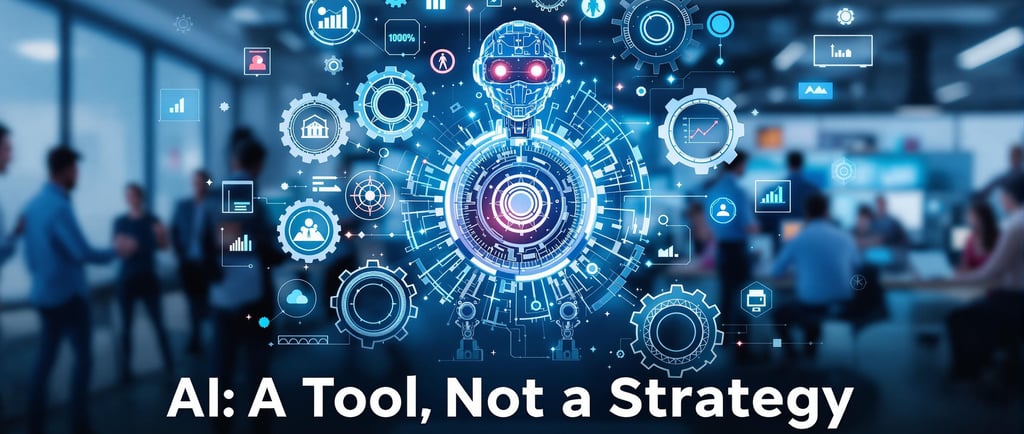AI Isn’t Magic, and It’s Not a Strategy Either
Artificial intelligence (AI) is undoubtedly a powerful tool, but let’s be clear: it’s not a strategy. You can use AI strategically, but simply adopting it doesn’t mean you have a strategy in place. This distinction is critical, yet it’s often misunderstood in the rush to embrace the latest technological advancements.
GROWTH PLANAI
Vince Calabrese
1/13/20254 min read


Artificial intelligence (AI) is undoubtedly a powerful tool, but let’s be clear: it’s not a strategy. You can use AI strategically, and even leverage it to help create strategies or plans, but the real challenge lies in implementing and executing those plans effectively. This distinction is critical, yet it’s often misunderstood in the rush to embrace the latest technological advancements.
The 10-Year Memory Problem
There’s a saying that industries have a memory of only 10 years. Lessons learned—whether about what to avoid or what to prioritize—tend to fade after a decade, only to be painfully relearned. This cycle is especially evident when it comes to new innovations, whose potential impact is almost always exaggerated.
Think back to past technological revolutions. When the internet became mainstream, many predicted the death of brick-and-mortar stores. While e-commerce has certainly transformed retail, physical stores are still very much alive. Similarly, the rise of smartphones was expected to eliminate the need for desktop computers. Yet, desktops remain essential for many tasks, even as mobile devices dominate our daily lives.
The same pattern applies to AI. It’s a transformative tool, but its true value lies in how it’s integrated into broader strategies—not in the tool itself.
Tools Are Not Strategies
AI, like any other innovation, is just a tool. Its impact depends entirely on the purpose it serves. Yet, many organizations fall into the trap of treating AI as if it is the strategy. Statements like “We’ll use more AI in 2025” are not strategies—they’re vague aspirations.
This confusion between tools and strategy isn’t new, but it’s particularly dangerous with AI because of its perceived “magic.” The excitement around AI’s capabilities often leads organizations to focus on the tool rather than the goals it’s meant to achieve.
AI Can Help Create Strategies, But Execution Is the Hard Part
To be fair, AI can play a significant role in helping organizations develop strategies. For example, AI can analyze vast amounts of data to identify trends, predict customer behavior, or optimize supply chains. It can even generate detailed plans or recommendations based on this analysis.
However, creating a strategy is only the first step. The real challenge lies in implementing and executing that strategy. This is where many organizations falter. AI might tell you what to do, but it can’t ensure that your teams are aligned, your processes are efficient, or your culture supports the changes needed to succeed.
Execution requires human leadership, coordination, and adaptability—qualities that no AI can replicate. Without these, even the most sophisticated AI-generated strategy will fail to deliver results.
The Risks of Overreliance on AI
In my research, I’ve spoken with leaders at organizations considered pioneers in AI. Even those developing the technology are often awestruck by its potential. Over the past few years, many companies have rushed to implement AI, driven by its promises of efficiency, innovation, and competitive advantage.
However, this rush has led to two major concerns:
The Unpredictable Power of AI
AI is proving to be more powerful—and less predictable—than even its creators anticipated. In 2023, several leading firms called for a pause to reflect on AI’s broader implications. They recognized the need to consider potential ripple effects and establish shared guidelines. While some companies agreed in principle, few were willing to slow down. The allure of AI’s potential rewards was simply too strong.Losing Sight of Core Business Goals
Perhaps more troubling is the way AI has caused some organizations to lose focus. In their eagerness to adopt AI, many companies have struggled to answer basic questions like, “What business are we in?” The tool has become the focus, rather than the strategy it’s supposed to support. This inversion of priorities is a growing trend, and it’s a costly mistake.
A recent report from McKinsey & Company highlighted this issue, warning that many organizations are confusing tools and tactics with strategy. McKinsey urged companies to “reset” their approach, emphasizing that competitive advantage comes from building organizational and technological capabilities—not from blindly adopting AI.
The Hard Truth About Strategy
The reality is that strategy is not a one-time decision. It’s an ongoing process of recalculating, reorganizing, and refining how all the pieces of an organization fit together. Tools like AI can play a role in this process, but they’re not a substitute for strategic thinking.
McKinsey put it bluntly: “With 2024 shaping up to be the year for AI to prove its value, companies should keep in mind the hard lessons learned … that competitive advantage comes from building organizational and technological capabilities.” In other words, AI isn’t a magic solution. To truly leverage its potential, businesses need to rethink how they operate—what McKinsey calls “rewiring the business.”
Moving Forward
AI will undoubtedly bring change. It already has. But the advantages it offers will likely differ from the grand predictions we hear today. To succeed, organizations must resist the temptation to treat AI as a standalone strategy. Instead, they should focus on integrating it thoughtfully into their broader goals and plans.
And while AI can help create strategies, the real work begins with execution. This means ensuring that the organization has the right people, processes, and culture in place to bring those strategies to life. AI can assist, but it can’t replace the human effort required to turn plans into reality.
The lesson here is simple: no tool, no matter how advanced, can replace the need for strategic thought, effort, and execution. AI is powerful, but it’s not a shortcut to success. It’s just one piece of the puzzle—and it’s up to leaders to figure out how it fits.
